Orthogonal Experimental Study on the Construction of a Similar Material Proportional Model for Simulated Coal Seam Sampling
Abstract
1. Introduction
2. Similar Materials Experiments
2.1. Design of Orthogonal Experiments and Selection of Material Proportion
- (1)
- The mechanical parameters of the model closely resemble those of the simulated coal body;
- (2)
- The materials exhibit stable mechanical performance during testing, being less susceptible to environmental factors;
- (3)
- The material proportions and specific mechanical parameters can be modified and adjusted to meet the requirements of similar conditions;
- (4)
- The manufacturing process is convenient, with a short setting time;
- (5)
- The materials offer advantages such as low cost and abundant availability of resources.
2.2. Procedures for Making Similar Materials Specimens
- (1)
- Selecting raw materials: choose coal powder, cement, gypsum, and sand according to Table 1. Considering the various properties and complex influencing elements of pulverized coal, the coal powder was selected with a fixed proportion of particle size. The coal sample was smashed using the drop hammer method and classified using a standard sieve to select a 0.2 mm particle size of coal powder [15];
- (2)
- Weighing: use an electronic balance to weigh the material according to the proportions in Table 1;
- (3)
- Stirring: after thoroughly blending all the raw materials, gradually add the pre-weighed water to the mixture. Simultaneously, stir the mixture slowly and steadily to prevent discrepancies in the initial moisture content of similar materials caused by water splashing. It was crucial to control the process within 5 min to prevent material agglomeration, which could affect the strength of the specimens;
- (4)
- Filling the mold: pour the homogeneous slurry into a 50 mm × 100 mm mold;
- (5)
- Conservation: place the specimens in a constant temperature and humidity maintenance chamber to keep them at a relatively uniform temperature and undergo natural drying for a duration of over 14 days in accordance with the related standards;
- (6)
- Molding: pry the side of the mold with an awl to loosen the specimen from the inner surface of the mold and release it.
3. Parametric Results and Discussion
3.1. Determine the Mechanical Parameters
3.2. Sensitivity Analysis
3.2.1. Analysis of Extreme Deviations
3.2.2. Analysis of Variance
3.3. Effect of Moisture Content on Similar Materials
- (1)
- Place the test block on an electronic scale (0.1 g) to obtain its wet weight (Mw);
- (2)
- Use a drying oven to dry the fractured test block, after which its dry weight (Md) was measured;
- (3)
- Calculate the moisture content of the test block using the following equation [14]:
3.4. Analysis of Similar Material Patterns
3.5. Constructing the Model
3.6. Model Proportioning Validation and Application
4. Stimulated Sampling Experiments
4.1. Preparation of Large-Sized Specimens
4.2. Ground Sampling
5. Conclusions
- (1)
- Orthogonal experimental methods were applied to study the effects of cement and coal powder on the compressive strength, elastic modulus, and Poisson’s ratio density of similar materials. Cement was the primary controlling factor for each parameter. The influence of moisture content on the compressive strength and elastic modulus of similar materials was investigated. A mathematical equation was fitted to establish the relationship between moisture content and strength of similar materials, thereby providing ideas for future research on the association between moisture content and strength in such materials.
- (2)
- A fitting analysis of the experimental data determined the fitting equation that correlates compressive strength, elastic modulus, moisture content, Poisson’s ratio, and density with the proportions of cement and coal powder. The error of the fitting formula was judged to be kept within a reasonable range by analyzing R2 and the plot of actual versus calculated values. From the experimental data obtained at different ratios, a proportional model was developed to establish the relationship between compressive strength, elastic modulus, Poisson’s ratio, and density of similar materials. This model enables the determination of the cement–coal powder proportions and moisture content by submitting the given parameters of the raw coal. The approximate ranges of parameters that can be achieved by this model are as follows: compressive strength of 1 to 11.4 MPa, elastic modulus of 0.27 to 3.62 GPa, Poisson’s ratio of 0.229 to 0.357, and density of 1.044 to 1.341 g·cm−3.
- (3)
- This study produced a new kind of similar material depending on the proportioning model. Sampling simulation experiments on coal seams were conducted successfully through a self-developed experimental drilling platform. The large-sized sample was taken out and weighed. The volume of collected debris accounted for over 90% of the total volume of the sampling jar, meeting the sampling requirements. These results effectively demonstrated the feasibility of similar materials for the simulation of coal seam sampling and further validated the reliability of the proportioning model.
Author Contributions
Funding
Data Availability Statement
Acknowledgments
Conflicts of Interest
References
- Wang, B. The Experimental Design and Research of Coaly Similar Materials Based on Uniform Design Method. Adv. Mater. Res. 2013, 850–851, 233–236. [Google Scholar] [CrossRef]
- Zhang, S.; Dai, L.; Wang, B.; Cao, J. Experimental Study on the Proportioning of Similar Materials for Simulating Coal and Gas Outburst. Coal Sci. Technol. 2015, 43, 76–80+145. [Google Scholar]
- Wang, G.; Li, W.; Wang, P.; Yang, X.; Zhang, S. Deformation and gas flow characteristics of coal-like materials under triaxial stress conditions. Int. J. Rock Mech. Min. Sci. 2017, 91, 72–80. [Google Scholar] [CrossRef]
- Qin, L. Research on Pore Structure Evolution Characteristics and Permeability Enhancement Mechanism of Liquid Nitrogen Cycle Fracturing Coal. Ph.D. Thesis, China University of Mining and Technology, Beijing, China, 2018. [Google Scholar]
- Li, S.; Bie, C.; Zhao, P.; Li, L.; Lin, H. A Study on the Factors Influencing the Characteristics of Novel “Solid Gas” Coupled Similar Materials. J. Min. Saf. Eng. 2017, 34, 981–986. [Google Scholar]
- Wu, B.; Zhu, H.; Xu, Q.; Ming, J. Experimental Study on Similar Materials of Class IV Weak Surrounding Rock. Geotech. Mech. 2013, 34, 109–116. [Google Scholar]
- Cui, X.; Miao, X.; Su, D.; Ma, W. Error analysis of simulation test of similar materials for strata and surface movement. J. Rock Mech. Eng. 2002, 12, 1827–1830. [Google Scholar]
- Liu, Q.; Chen, S.; Wang, S.; Chai, J.; Zhang, D. Experimental Development Process of a New Cement and Gypsum-Cemented Similar Material considering the Effect of Moisture. Geofluids 2020, 2020, 8831801. [Google Scholar] [CrossRef]
- Chen, S.; Wang, H.; Zhang, J.; Xing, H.; Wang, H. Experimental Study on Low-Strength Similar-Material Proportioning and Properties for Coal Mining. Adv. Mater. Sci. Eng. 2015, 2015, 696501. [Google Scholar] [CrossRef]
- Ning, Y.; Tang, H.; Zhang, B.; Shen, P.; Zhang, G.; Xia, D. Research on Rock Similar Material Proportioning Based on Orthogonal Design and Application of Bottom Friction Physical Model Test. Geotech. Mech. 2020, 41, 2009–2020. [Google Scholar]
- Liu, Y.; Zhou, W.; Guo, B.; Ma, Q.; Xiao, H. Research on similar materials of marl in similar model experiment. J. Rock Mech. Eng. 2020, 39, 2795–2803. [Google Scholar]
- Hu, Q.; Zhang, S.; Wen, G.; Dai, L.; Wang, B. Coal-like material for coal and gas outburst simulation tests. Int. J. Rock Mech. Min. Sci. 2015, 74, 151–156. [Google Scholar] [CrossRef]
- Dai, Y.; Wang, M.; Wu, L.; Yan, Z. Research on the Effect of Admixtures on the Properties of Cement-based Similar Materials. Coal Sci. Technol. 2016, 44, 14–18. [Google Scholar]
- Li, H.; Guo, G.; Zha, J. Study on time-varying characteristics of similar material model strength and the regulation measures. Environ. Earth Sci. 2017, 76, 518. [Google Scholar] [CrossRef]
- Sun, H.; Zhu, M.; Cao, J.; Wen, G. Orthogonal experimental study on the construction of a similar material ratio model for outburst coal seams. Coal Sci. Technol. 2019, 47, 116–122. [Google Scholar]
- Wang, X. Research on the Methods for Obtaining Mechanical Parameters in Rock Mass Engineering I: In Situ Testing and Quantitative Analogy. J. Water Resour. 2023, 54, 13–23. [Google Scholar]
- Feng, G.; Fan, Y.; Wang, P.; Guo, J.; Wen, X.; Qian, R.; Zhu, L.; Zhang, P. Analysis of damage and failure process of rock like specimens under uniaxial compression under different material combinations and ratios. J. Rock Mech. Eng. 2023, 42, 3377–3390. [Google Scholar]
- Zhan, K.; Xue, J. Development and Properties of a Similar Material to Coal. Energies 2022, 15, 6922. [Google Scholar] [CrossRef]
- Yang, J. Development and application of a stress testing device for similar material model experiments. Coal Sci. Technol. 2019, 47, 114–119. [Google Scholar]
- Li, S.; Qian, M.; Shi, P. Permeability coefficient strain equation during the full stress-strain process of coal samples. Coal Geol. Explor. 2001, 29, 22–24. [Google Scholar]
- Chang, J. Research on Dynamic Identification of Mechanical Characteristics of Surrounding Rock during Impact Rotary Drilling with Holes. Master’s Thesis, China University of Mining and Technology, Beijing, China, 2019. [Google Scholar]
- Wang, P.; Shu, C.; Shi, F.; Hu, G.; Wang, H. Orthogonal experimental study on mechanical properties of materials with similar sand cement ratios, densities, and water content. Geotech. Mech. 2017, 38, 229–235. [Google Scholar]
- Lei, S.; Gao, F.; Wang, X. Research on Statistics and Classification of Uniaxial Compressive Strength of Coal Body. Coal Sci. Technol. 2021, 49, 64–70. [Google Scholar]
- Lei, S.; Gao, F. Laboratory coal deformation characteristics analysis and elastic modulus correlation model. J. Min. Rock Control Eng. 2021, 3, 51–59. [Google Scholar]
- Zhu, M. Experimental Study on the Ratio Model of Similar Materials for Outburst Coal Based on Orthogonal Experiments. Master’s Thesis, General Institute of Coal Science Research, Chongqing, China, 2019. [Google Scholar]
- Chen, W. Analysis on relationship between stress and drill cutting weight using numerical modeling A case study in Jinjiazhuang coal mine. Saf. Sci. 2012, 50, 923–926. [Google Scholar]
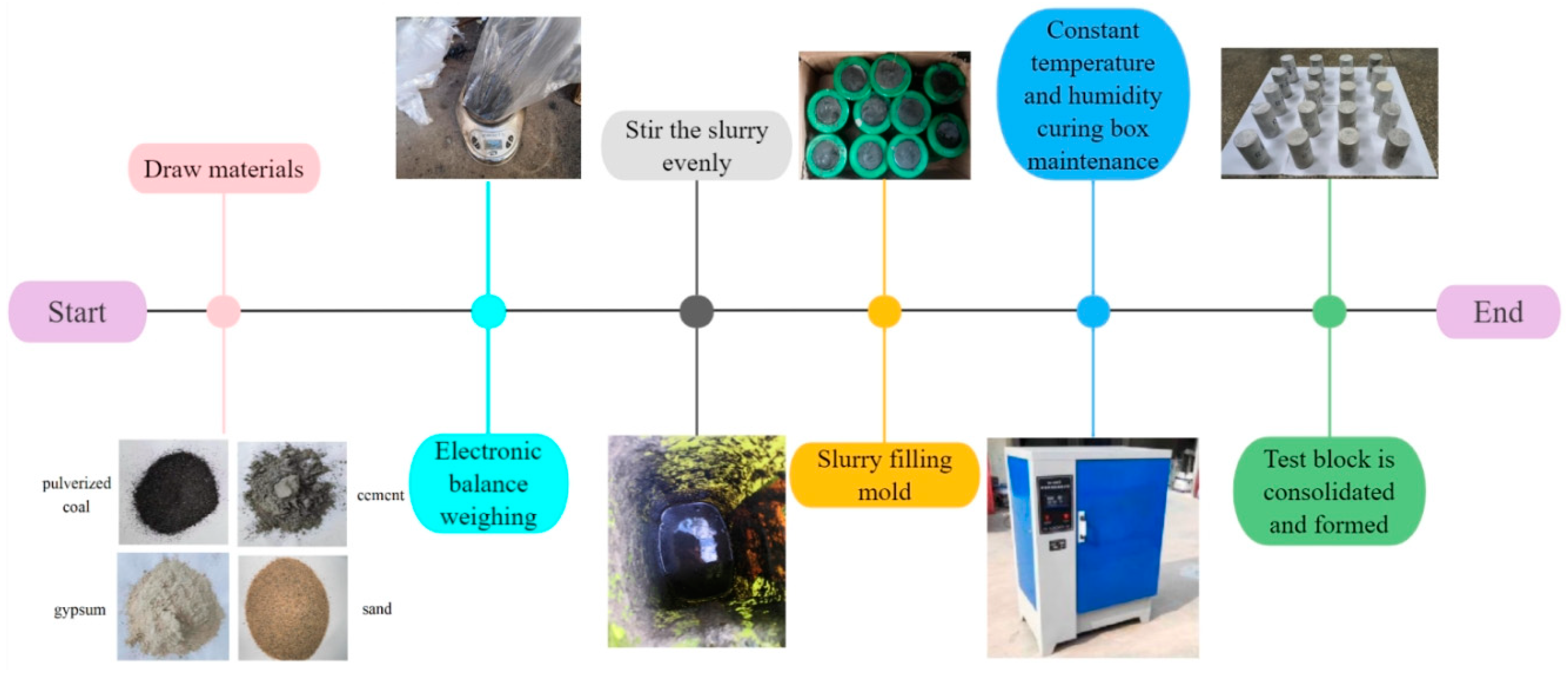

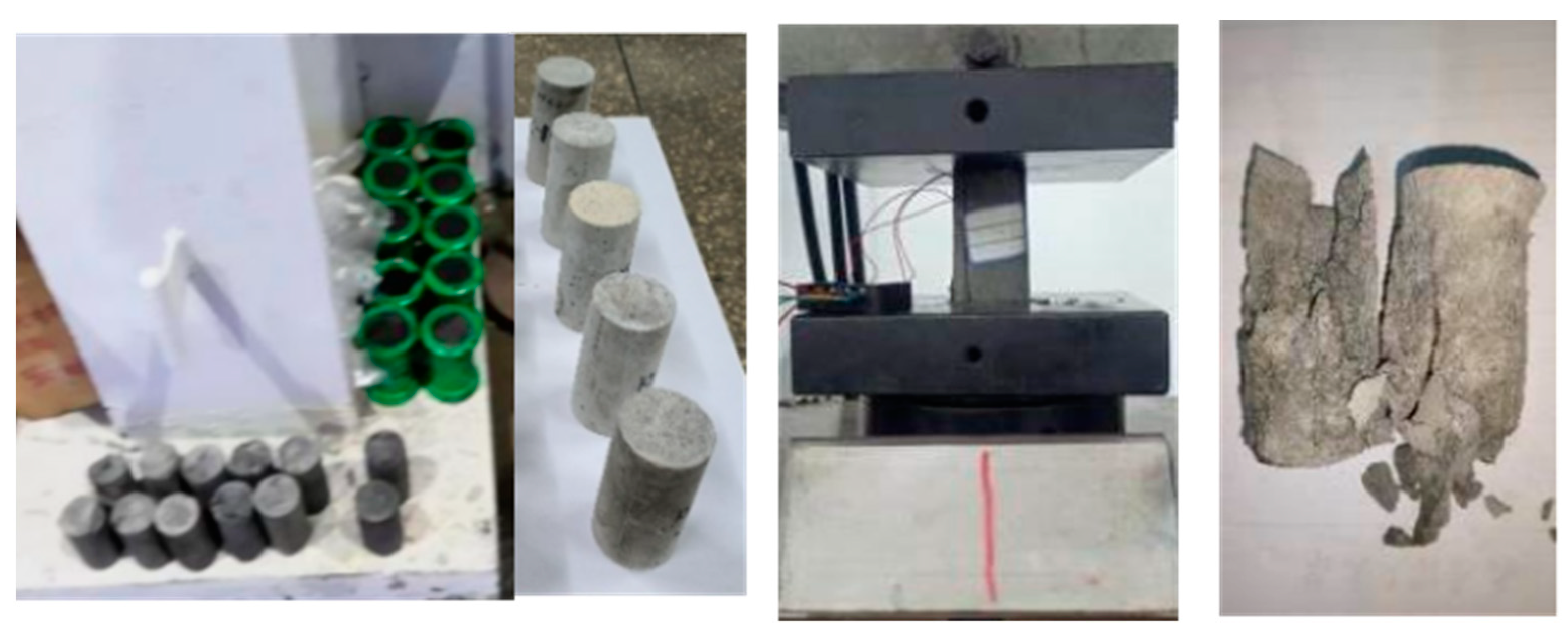

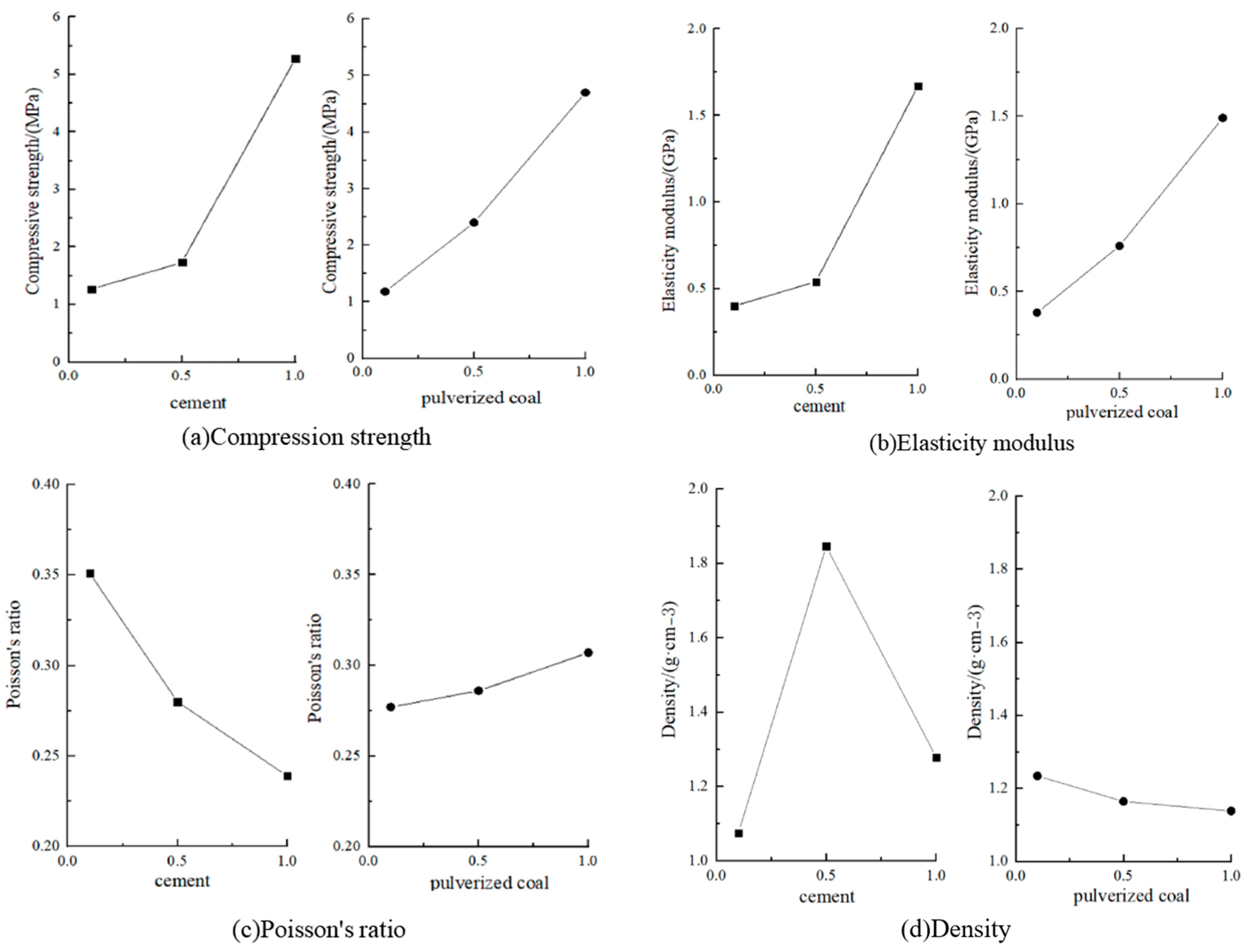
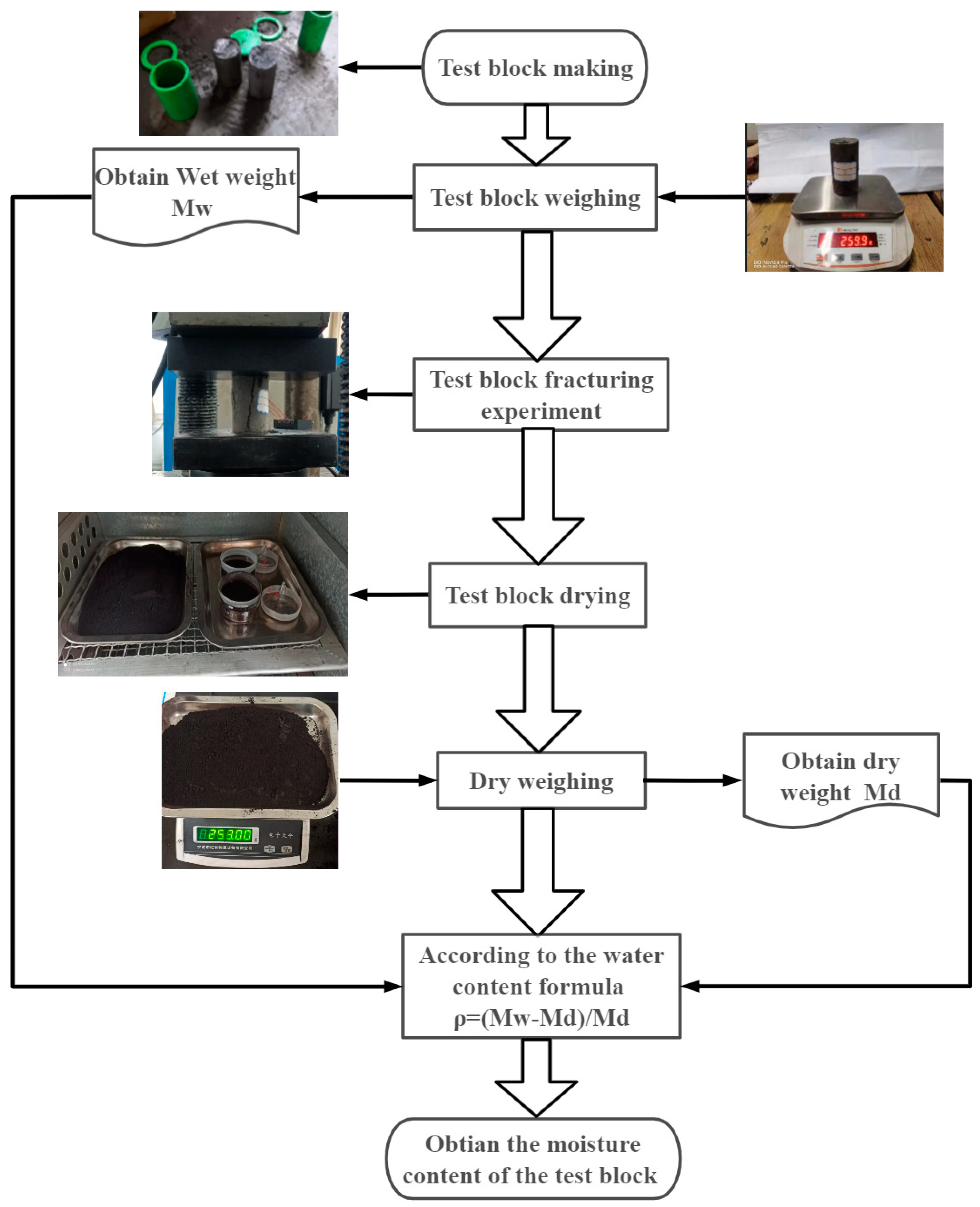
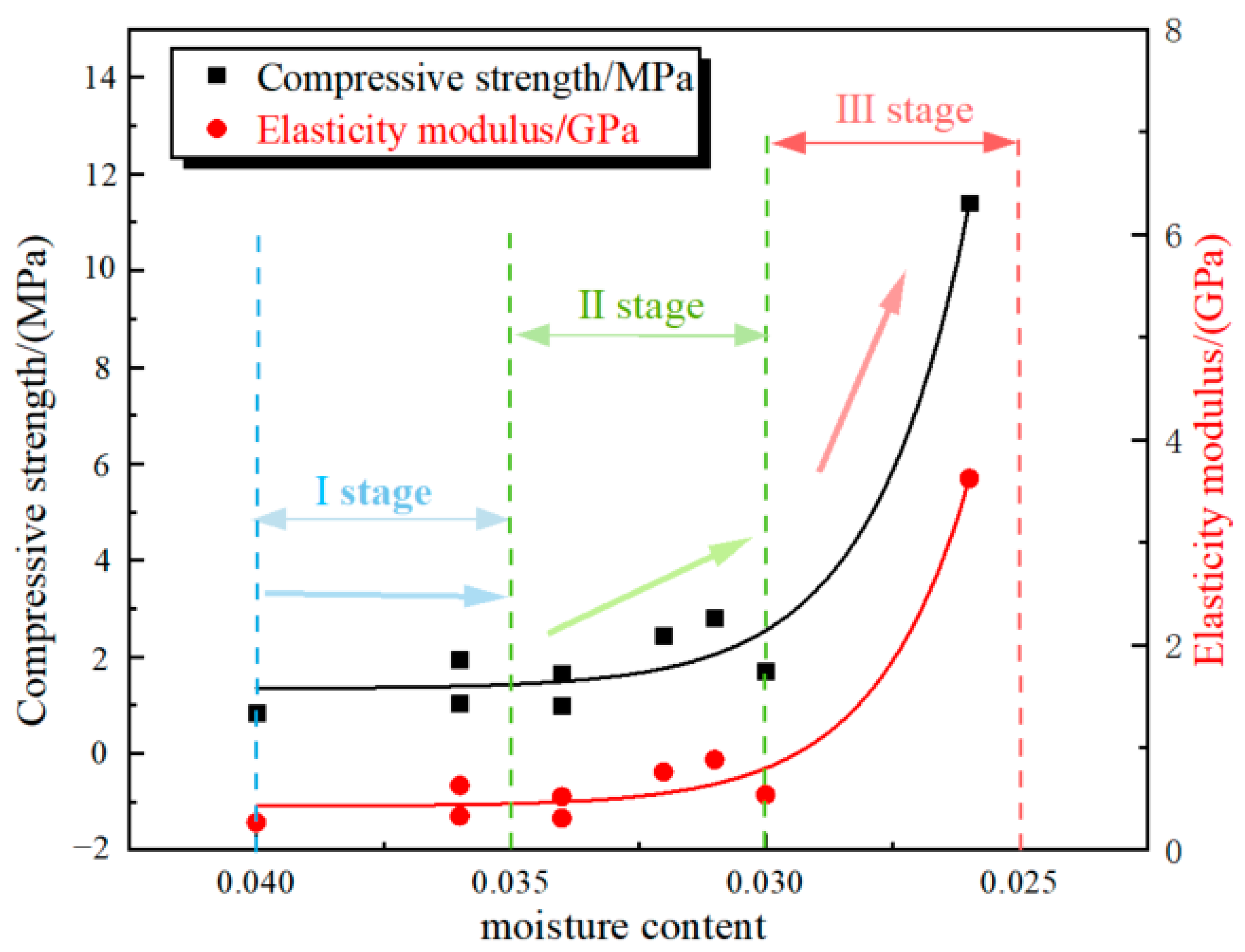
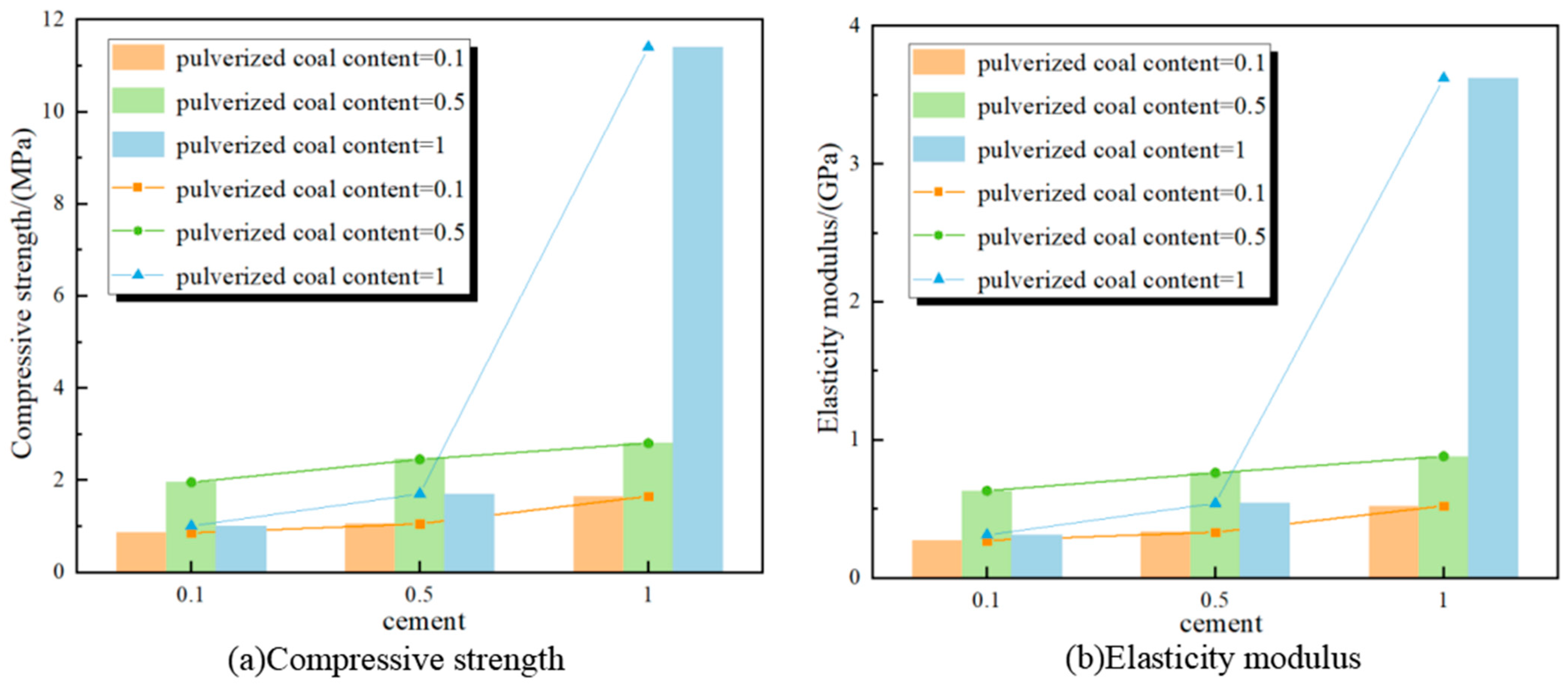
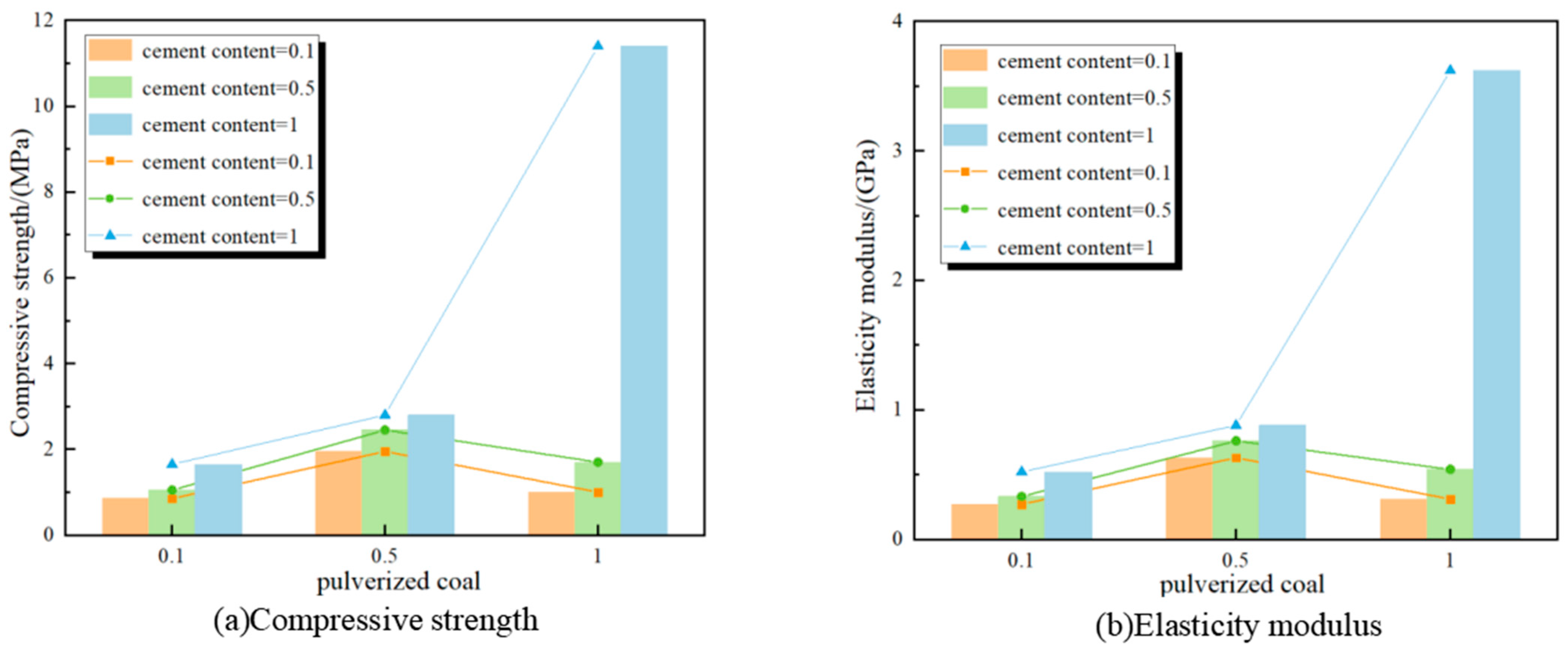
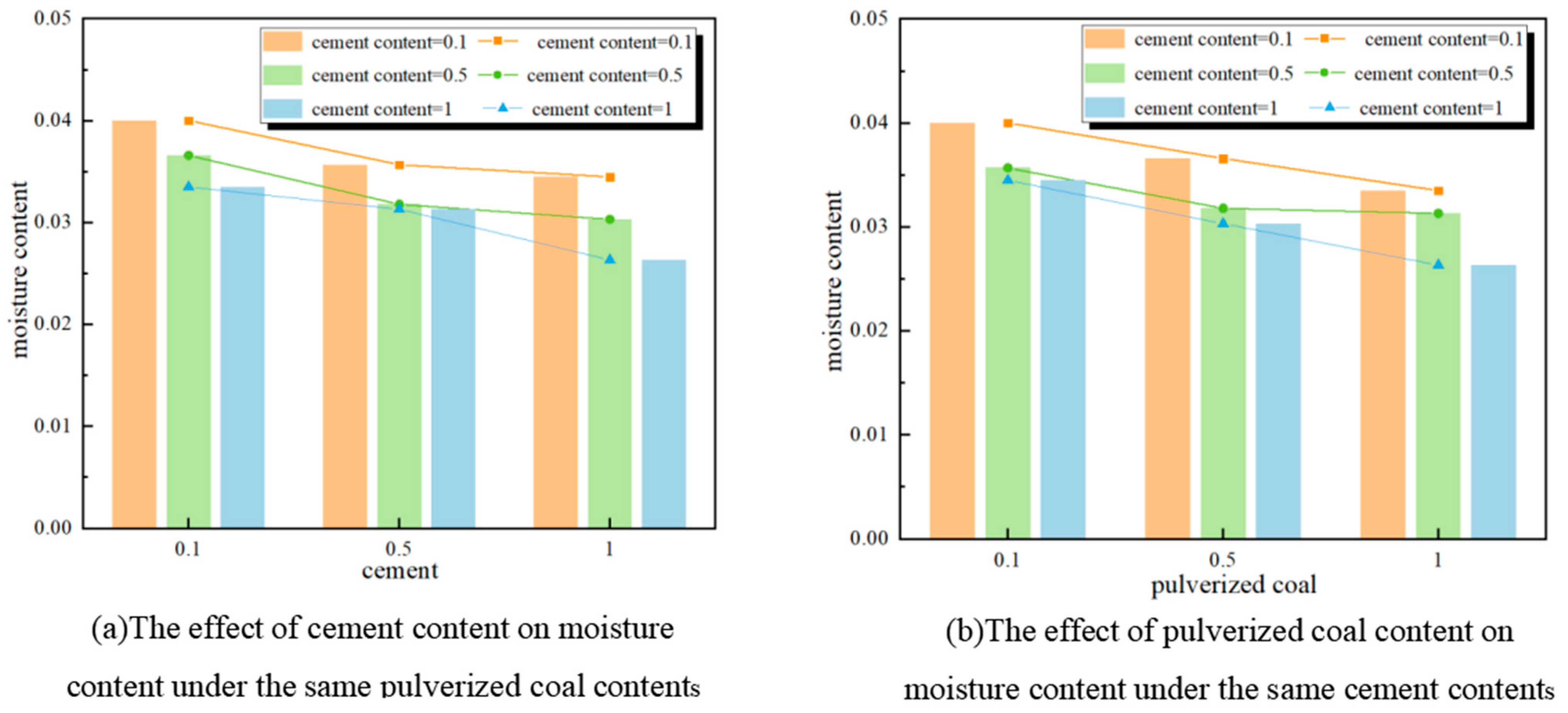

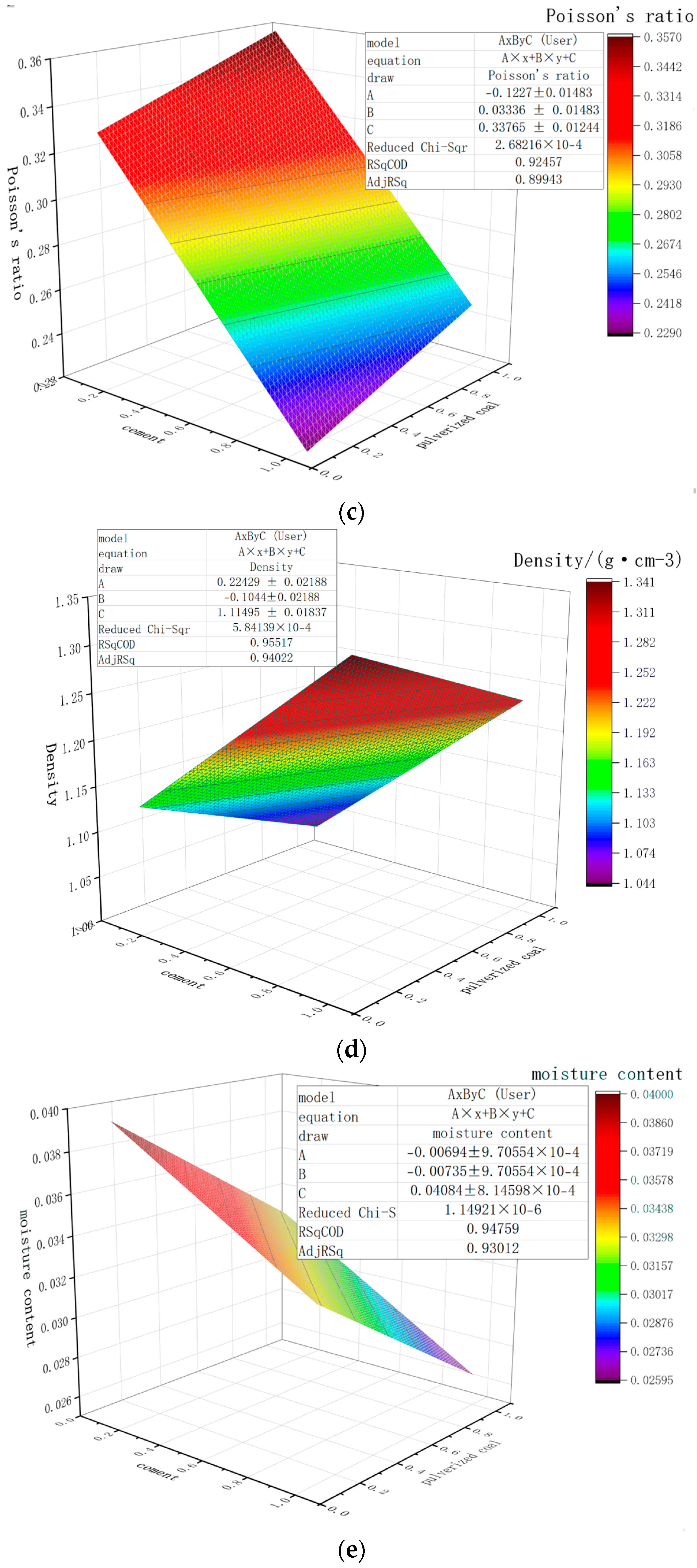
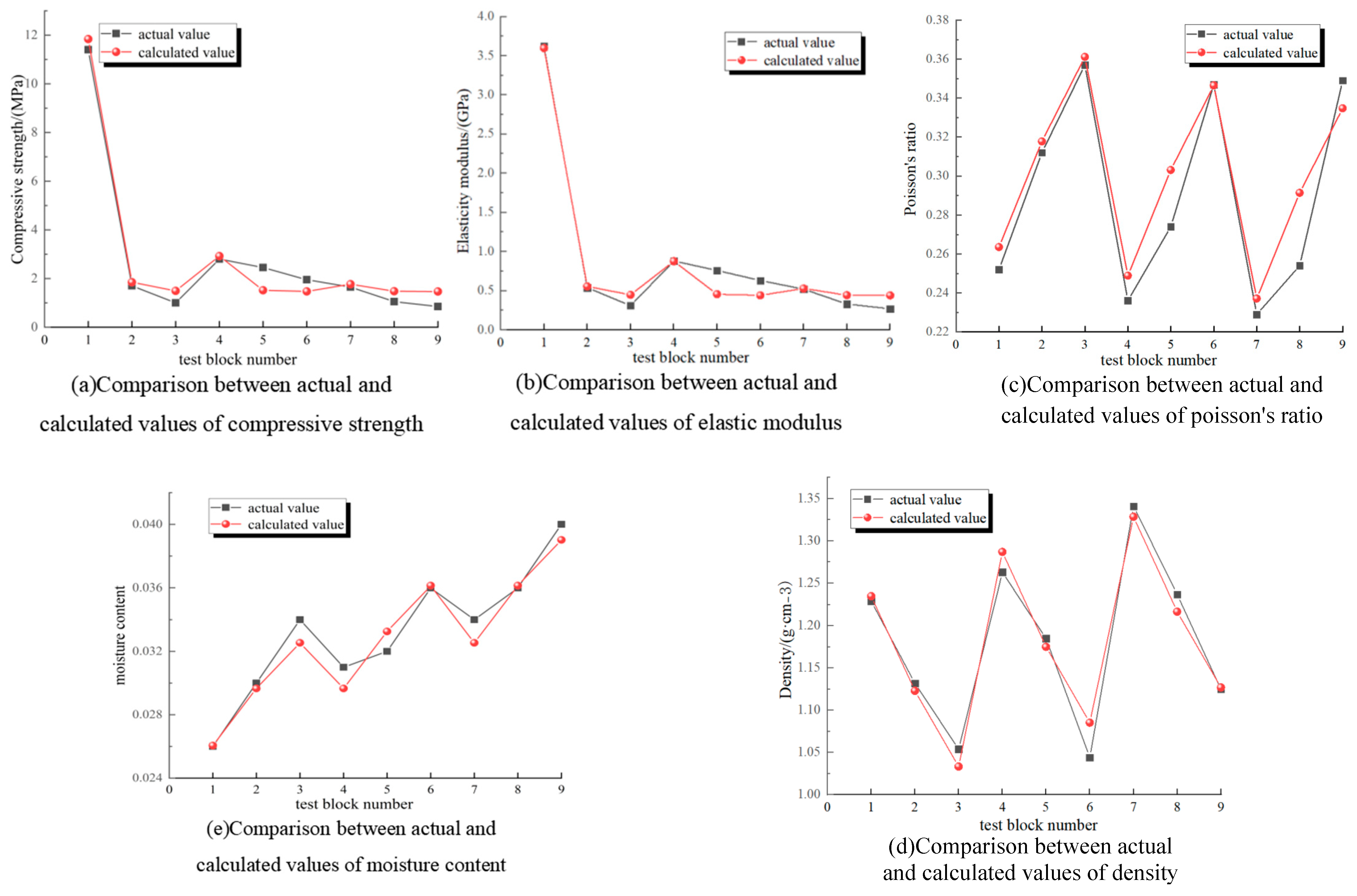
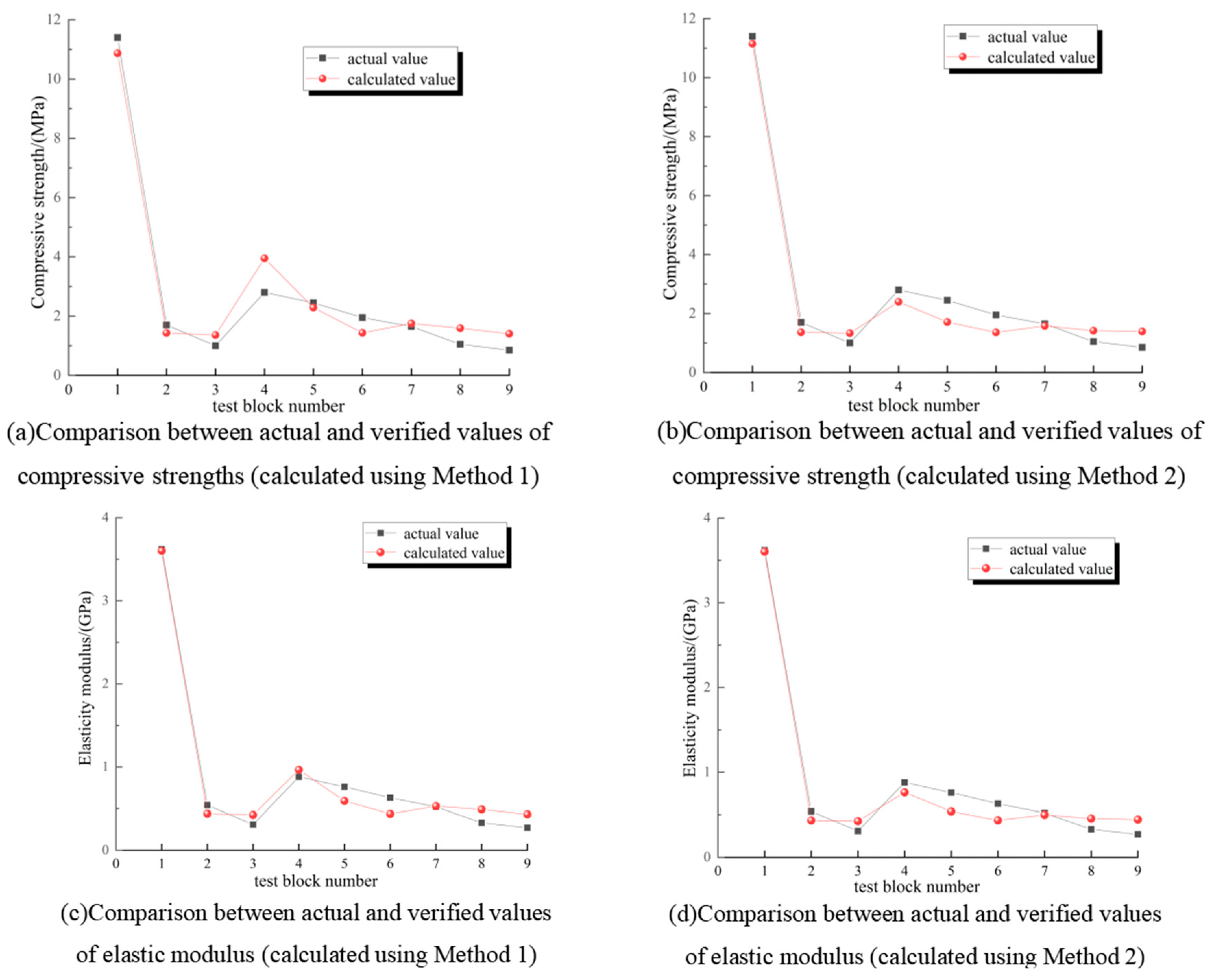
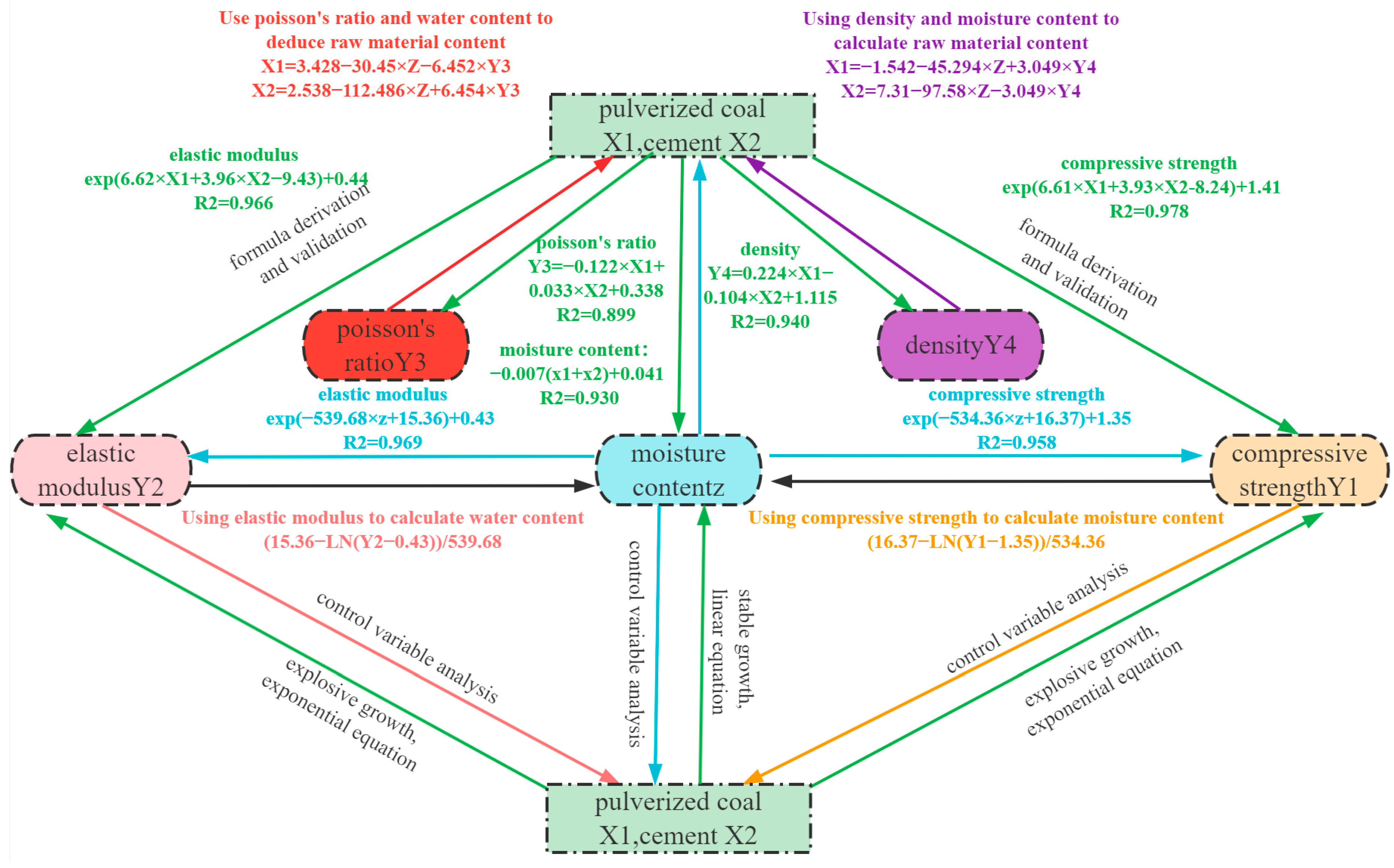
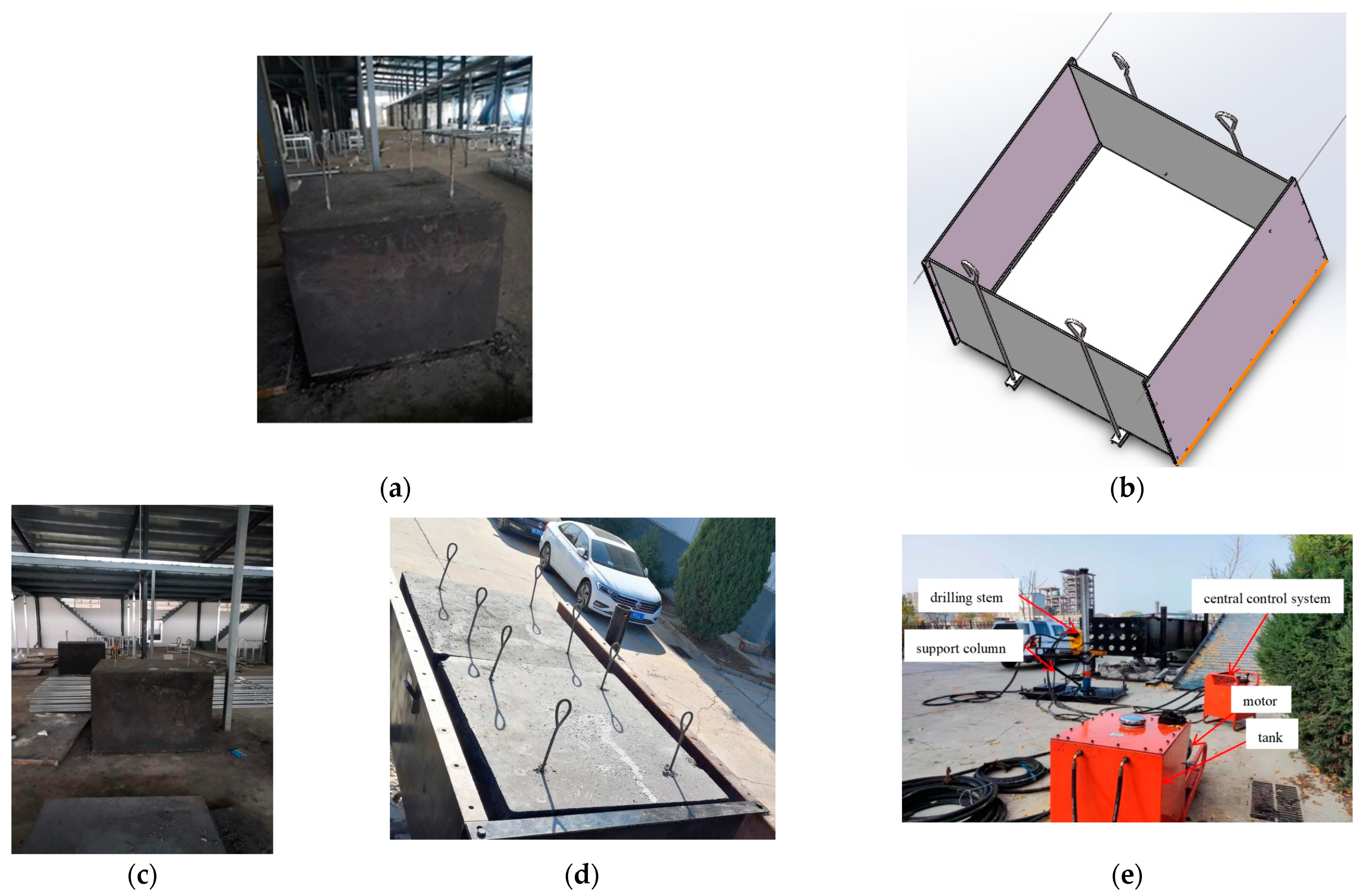
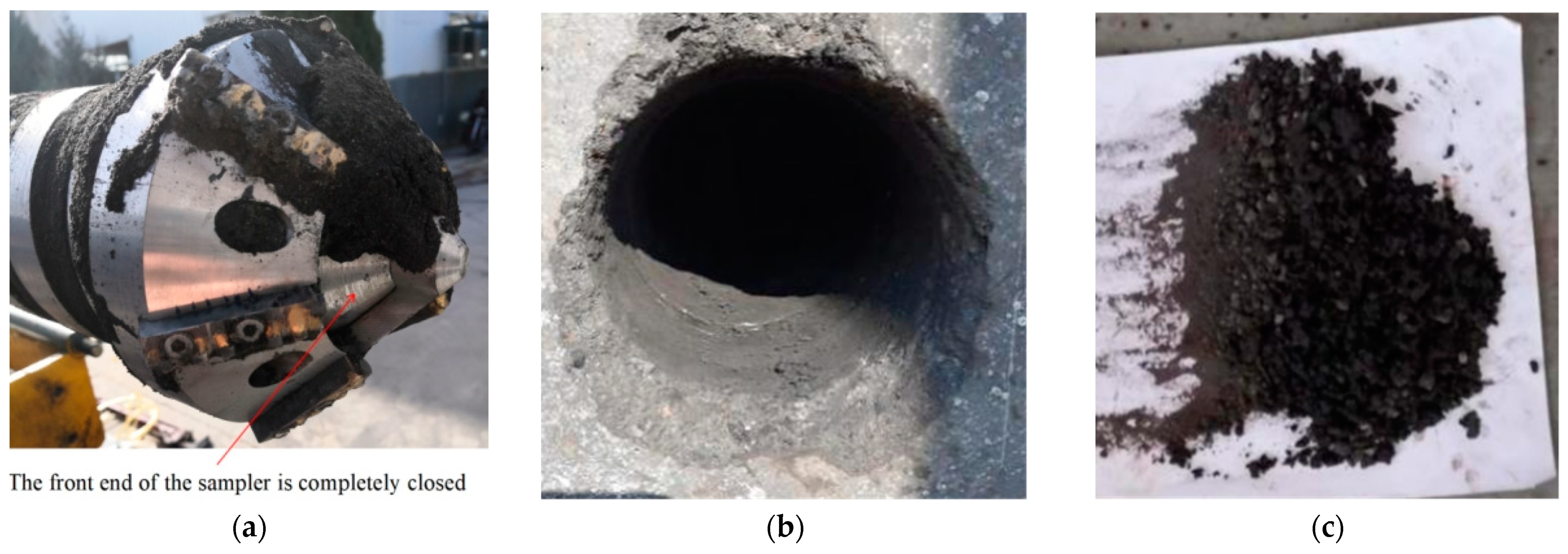
| Sample Grouping | Coal Powder:Water | Cement:Water | Sand | Gypsum:Water |
|---|---|---|---|---|
| Sample 1 | 1 (level 1) | 1 (level 1) | 0.5 | 0.3 |
| Sample 2 | 1 | 0.5 (level 2) | 0.5 | 0.3 |
| Sample 3 | 1 | 0.1 (level 3) | 0.5 | 0.3 |
| Sample 4 | 0.5 (level 2) | 1 | 0.5 | 0.3 |
| Sample 5 | 0.5 | 0.5 | 0.5 | 0.3 |
| Sample 6 | 0.5 | 0.1 | 0.5 | 0.3 |
| Sample 7 | 0.1 (level 3) | 1 | 0.5 | 0.3 |
| Sample 8 | 0.1 | 0.5 | 0.5 | 0.3 |
| Sample 9 | 0.1 | 0.1 | 0.5 | 0.3 |
| Sample Number | Compressive Strength/(MPa) | Elastic Modulus/(GPa) | Poisson’s Ratio | Density/(g·cm−3) |
|---|---|---|---|---|
| Sample 1-1 | 11.2 | 3.52 | 0.235 | 1.232 |
| Sample 1-2 | 11.5 | 3.45 | 0.229 | 1.231 |
| Sample 1-3 | 11.5 | 3.5 | 0.292 | 1.224 |
| Average value | 11.4 | 3.49 | 0.252 | 1.229 |
| Sample 2-1 | 1.72 | 0.54 | 0.315 | 1.129 |
| Sample 2-2 | 1.65 | 0.52 | 0.301 | 1.134 |
| Sample 2-3 | 1.73 | 0.56 | 0.320 | 1.133 |
| Average value | 1.70 | 0.54 | 0.312 | 1.132 |
| Sample 3-1 | 1.09 | 0.32 | 0.351 | 1.051 |
| Sample 3-2 | 0.93 | 0.3 | 0.361 | 1.059 |
| Sample 3-3 | 0.98 | 0.31 | 0.359 | 1.052 |
| Average value | 1.00 | 0.31 | 0.357 | 1.054 |
| Sample 4-1 | 2.67 | 0.86 | 0.234 | 1.254 |
| Sample 4-2 | 2.92 | 0.92 | 0.235 | 1.324 |
| Sample 4-3 | 2.81 | 0.86 | 0.239 | 1.211 |
| Average value | 2.8 | 0.88 | 0.236 | 1.263 |
| Sample 5-1 | 2.64 | 0.68 | 0.270 | 1.111 |
| Sample 5-2 | 2.29 | 0.81 | 0.266 | 1.391 |
| Sample 5-3 | 2.42 | 0.79 | 0.286 | 1.053 |
| Average value | 2.45 | 0.76 | 0.274 | 1.185 |
| Sample 6-1 | 1.98 | 0.64 | 0.348 | 1.094 |
| Sample 6-2 | 1.91 | 0.58 | 0.351 | 0.874 |
| Sample 6-3 | 1.96 | 0.67 | 0.342 | 1.164 |
| Average value | 1.95 | 0.63 | 0.347 | 1.044 |
| Sample 7-1 | 1.62 | 0.5 | 0.215 | 1.244 |
| Sample 7-2 | 1.73 | 0.52 | 0.242 | 1.414 |
| Sample 7-3 | 1.6 | 0.54 | 0.230 | 1.365 |
| Average value | 1.65 | 0.52 | 0.229 | 1.341 |
| Sample 8-1 | 1.02 | 0.35 | 0.253 | 1.234 |
| Sample 8-2 | 1.14 | 0.28 | 0.254 | 1.252 |
| Sample 8-3 | 0.99 | 0.36 | 0.255 | 1.225 |
| Average value | 1.05 | 0.33 | 0.254 | 1.237 |
| Sample 9-1 | 0.84 | 0.29 | 0.351 | 1.227 |
| Sample 9-2 | 0.93 | 0.21 | 0.347 | 1.147 |
| Sample 9-3 | 0.78 | 0.31 | 0.350 | 1.001 |
| Average value | 0.85 | 0.27 | 0.349 | 1.125 |
| Compressive Strength/(MPa) | Elastic Modulus/(GPa) | Poisson’s Ratio | Density/(g·cm−3) | |||||
|---|---|---|---|---|---|---|---|---|
| Factor | Cement | Pulverized coal | Cement | Pulverized coal | Cement | Pulverized coal | Cement | Pulverized coal |
| Average of level 1 | 5.28 | 4.70 | 1.67 | 1.49 | 0.239 | 0.307 | 1.278 | 1.138 |
| Average of level 2 | 1.73 | 2.40 | 0.54 | 0.76 | 0.280 | 0.286 | 1.845 | 1.164 |
| Average of level 3 | 1.27 | 1.18 | 0.40 | 0.38 | 0.351 | 0.277 | 1.074 | 1.234 |
| Range | 4.01 | 3.52 | 1.27 | 1.11 | 0.112 | 0.030 | 0.204 | 0.096 |
| Variance Analysis of Compressive Strength | Variance Analysis of Elastic Modulus | ||||||
| Factor | Deviations sum of squares | Mean square | F | Factor | Deviations sum of squares | Mean square | F |
| Cement | 28.95 | 14.47 | 1.47 | Cement | 2.90 | 1.45 | 1.46 |
| Pulverized coal | 19.14 | 9.57 | 0.97 | Pulverized coal | 1.93 | 0.97 | 0.97 |
| Error | 39.34 | 9.84 | Error | 3.98 | 0.99 | ||
| Variance Analysis of Poisson’s Ratio | Variance Analysis of Density | ||||||
| Factor | Deviations sum of squares | Mean square | F | Factor | Deviations sum of squares | Mean square | F |
| Cement | 0.0193 | 0.0096 | 57.83 | Cement | 0.0621 | 0.031 | 104.38 |
| Pulverized coal | 0.0014 | 7.02 × 10−4 | 4.22 | Pulverized coal | 0.0148 | 0.007 | 23.57 |
| Error | 6.65 × 10−4 | 1.66 × 10−4 | Error | 0.0012 | 2.97 × 10−4 | ||
| Test Block Number | Cement:Water | Pulverized Coal:Water | Moisture Content |
|---|---|---|---|
| 1 | 1 | 1 | 0.026 |
| 2 | 0.5 | 1 | 0.030 |
| 3 | 0.1 | 1 | 0.034 |
| 4 | 1 | 0.5 | 0.031 |
| 5 | 0.5 | 0.5 | 0.032 |
| 6 | 0.1 | 0.5 | 0.036 |
| 7 | 1 | 0.1 | 0.034 |
| 8 | 0.5 | 0.1 | 0.036 |
| 9 | 0.1 | 0.1 | 0.040 |
| Test Indicators | Influence Factor | Fitting Formula | R2 |
|---|---|---|---|
| Compressive strength | Cement, coal powder | Y1 = e^(6.61 × X1 + 3.93 × X2 − 8.24) + 1.41 | 0.978 |
| Elasticity modulus | Cement, coal powder | Y2 = e^(6.62 × X1 + 3.96 × X2 − 9.43) + 0.44 | 0.966 |
| Poisson ratio | Cement, coal powder | Y3 = −0.122 × X1 + 0.033 × X2 + 0.338 | 0.899 |
| Density | Cement, coal powder | Y4 = 0.224 × X1 − 0.104 × X2 + 1.115 | 0.940 |
| Moisture content | Cement, coal powder | Z = −0.007 × X1 − 0.007 × X2 + 0.041 | 0.930 |
| Step | Illustrate | Formula |
|---|---|---|
| Calculate moisture content | Determine moisture content based on compressive strength or elastic modulus | Z = (16.37 − ln(Y1 − 1.35))/534.36 |
| Z = (15.36 − ln(Y2 − 0.43))/539.68 | ||
| Calculation method 1 | Calculate the cement content according to the water content and Poisson’s ratio | X1 = 3.428 − 30.45 × Z − 6.452 × Y3 |
| Calculate the content of pulverized coal according to the water content and Poisson’s ratio | X2 = 2.538 − 112.486 × Z + 6.454 × Y3 | |
| Calculation method 2 | Determine the cement content based on moisture content and density | X1 = −1.542 − 45.294 × Z + 3.049 × Y4 |
| Determine the content of coal powder based on moisture content and density | X2 = 7.31 − 97.58 × Z − 3.049 × Y4 | |
| Test and verify | Use fitting formulas to reverse calculate compressive strength and elastic modulus for verification | Y1 = e^(6.61 × X1 + 3.93 × X2 − 8.24) + 1.41 |
| Y2 = e^(6.62 × X1 + 3.96 × X2 − 9.43) + 0.44 |
| Sampling Locations | Indicators of Raw Coal | Validation and Error | |||||||
|---|---|---|---|---|---|---|---|---|---|
| Average of Compressive Strength/MPa | Average of Elastic Modulus/GPa | Poisson’s Ratio | Compressive Strength/MPa | Error/% | Elastic Modulus/GPa | Error/% | Poisson’s Ratio | Error/% | |
| No. 3 coal seam in Gucheng coal mine | 8.69 | 2.52 | 0.32 | 8.09 | 6.90 | 2.32 | 7.93 | 0.30 | 6.25 |
| No. 13 coal seam in Lotus Hill coal mine | 5.24 | 0.97 | 0.24 | 4.84 | 17.85 | 1.09 | 18.56 | 0.24 | 0 |
| No. 9 coal seam in Hamijo Lake coal mine | 8.74 | 1.36 | 0.23 | 9.23 | 5.61 | 1.62 | 19.1 | 0.24 | 4.34 |
| Wangjiazhai coal mine | 1.78 | 1.33 | 0.28 | 1.72 | 3.37 | 1.58 | 11.2 | 0.29 | 3.57 |
| Compressive Strength/MPa | Elasticity Modulus/GPa | Poisson’s Ratio | |
|---|---|---|---|
| Lüliang Jinjiazhuang coal mine coal sample from coal seam 4 | 13.0 | 3.00 | 0.3 |
| Test block 1 | 11.4 | 3.49 | 0.252 |
| Relative error/% | 12.31 | 16.3 | 16 |
Disclaimer/Publisher’s Note: The statements, opinions and data contained in all publications are solely those of the individual author(s) and contributor(s) and not of MDPI and/or the editor(s). MDPI and/or the editor(s) disclaim responsibility for any injury to people or property resulting from any ideas, methods, instructions or products referred to in the content. |
© 2023 by the authors. Licensee MDPI, Basel, Switzerland. This article is an open access article distributed under the terms and conditions of the Creative Commons Attribution (CC BY) license (https://creativecommons.org/licenses/by/4.0/).
Share and Cite
Pang, J.; Zhang, X.; Zhang, B. Orthogonal Experimental Study on the Construction of a Similar Material Proportional Model for Simulated Coal Seam Sampling. Processes 2023, 11, 2125. https://doi.org/10.3390/pr11072125
Pang J, Zhang X, Zhang B. Orthogonal Experimental Study on the Construction of a Similar Material Proportional Model for Simulated Coal Seam Sampling. Processes. 2023; 11(7):2125. https://doi.org/10.3390/pr11072125
Chicago/Turabian StylePang, Jie, Xinghua Zhang, and Bailin Zhang. 2023. "Orthogonal Experimental Study on the Construction of a Similar Material Proportional Model for Simulated Coal Seam Sampling" Processes 11, no. 7: 2125. https://doi.org/10.3390/pr11072125
APA StylePang, J., Zhang, X., & Zhang, B. (2023). Orthogonal Experimental Study on the Construction of a Similar Material Proportional Model for Simulated Coal Seam Sampling. Processes, 11(7), 2125. https://doi.org/10.3390/pr11072125





